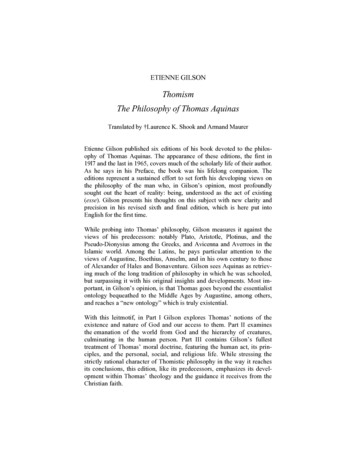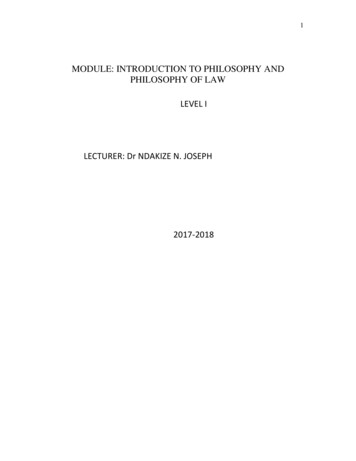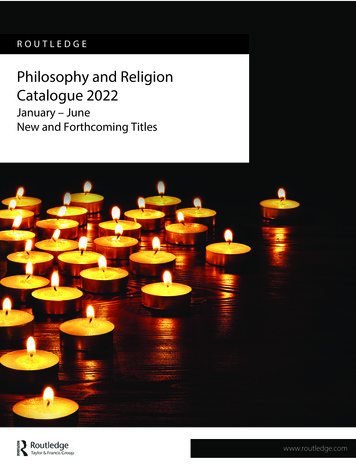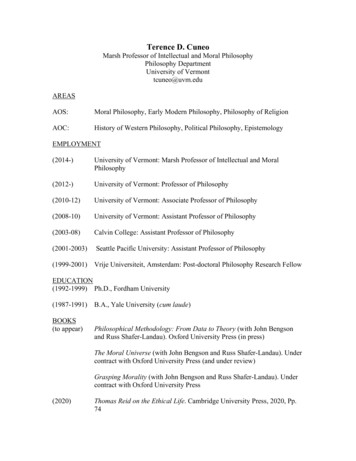
Transcription
ETIENNE GILSONThomismThe Philosophy of Thomas AquinasTranslated by †Laurence K. Shook and Armand MaurerEtienne Gilson published six editions of his book devoted to the philosophy of Thomas Aquinas. The appearance of these editions, the first in19l7 and the last in 1965, covers much of the scholarly life of their author.As he says in his Preface, the book was his lifelong companion. Theeditions represent a sustained effort to set forth his developing views onthe philosophy of the man who, in Gilson’s opinion, most profoundlysought out the heart of reality: being, understood as the act of existing(esse). Gilson presents his thoughts on this subject with new clarity andprecision in his revised sixth and final edition, which is here put intoEnglish for the first time.While probing into Thomas’ philosophy, Gilson measures it against theviews of his predecessors: notably Plato, Aristotle, Plotinus, and thePseudo-Dionysius among the Greeks, and Avicenna and Averroes in theIslamic world. Among the Latins, he pays particular attention to theviews of Augustine, Boethius, Anselm, and in his own century to thoseof Alexander of Hales and Bonaventure. Gilson sees Aquinas as retrieving much of the long tradition of philosophy in which he was schooled,but surpassing it with his original insights and developments. Most important, in Gilson’s opinion, is that Thomas goes beyond the essentialistontology bequeathed to the Middle Ages by Augustine, among others,and reaches a “new ontology” which is truly existential.With this leitmotif, in Part I Gilson explores Thomas’ notions of theexistence and nature of God and our access to them. Part II examinesthe emanation of the world from God and the hierarchy of creatures,culminating in the human person. Part III contains Gilson’s fullesttreatment of Thomas’ moral doctrine, featuring the human act, its principles, and the personal, social, and religious life. While stressing thestrictly rational character of Thomistic philosophy in the way it reachesits conclusions, this edition, like its predecessors, emphasizes its development within Thomas’ theology and the guidance it receives from theChristian faith.
ETIENNE GILSON SERIES 24Etienne GilsonThomismThe Philosophy of Thomas AquinasA translation ofLE THOMISMESixth and final editionby†Laurence K. ShookandArmand MaurerPONTIFICAL INSTITUTE OF MEDIAEVAL STUDIES
This book has been published with the aid of a grant from theLAURENCE K. SHOOK FUNDPontifical Institute of Mediaeval StudiesNational Library of Canada Cataloguing in PublicationGilson, Etienne, 1884-1978Thomism : the philosophy of Thomas Aquinas / Etienne Gilson ; atranslation of Le Thomisme, sixth and final edition by Laurence K.Shook and Armand Maurer.(Etienne Gilson series, ISSN 0708-319X ; 24)Includes bibliographical references and index.ISBN 0-88844-724-81. Thomas, Aquinas, Saint, 1225?-1274.I. Maurer, Armand A.(Armand Augustine), 1915II. Shook, Laurence K. (LaurenceKennedy), 1909-1993III. Pontifical Institute of Mediaeval StudiesIV. Title. V. Series.B765.T54G5413 2002189′.4 2002Pontifical Institute of Mediaeval Studies59 Queen’s Park Crescent EastToronto, Ontario, Canada M5S 2C4Printed in CanadaC2002-902906-6
The translation is dedicated toDonal P. Murnaghanand toDorothy V. Maurer
ContentsTranslator’s on: The Nature of Thomistic Philosophy1. The Doctrinal Framework2. The Philosopher and the Believer1127PART I: GODChapter 1. The Problem of the Existence of God1. The Alleged Evidence for the Existence of God2. The Theologies of Essence3. The Existence of God as a ProblemChapter 2. The Proofs of the Existence of God1. The Proof from Motion2. The Proof from Efficient Cause3. The Proof from Necessity4. The Proof from the Degrees of Being5. The Proof from Final Causality6. The Meaning and Significance of the Five WaysChapter 3. The Divine Being1. Haec Sublimis Veritas2. The Knowledge of Goda. The Knowledge of God by Way of Negationb. The Knowledge of God by Way of Analogy3. The Perfections of God4. The CreatorChapter 4. The Thomistic Reform1. A New Theology2. A New 137153
viiiCONTENTSPART II: NATUREChapter 1. CreationChapter 2. The AngelsChapter 3. The Corporeal World and the Efficacyof Secondary CausesChapter 4. The Human PersonChapter 5. Life and the SensesChapter 6. The Intellect and Rational KnowledgeChapter 7. Knowledge and TruthChapter 8. Appetite and Will175189204219233241259274PART III: MORAL SCIENCEChapter 1. The Human Act1. The Structure of the Human Act2. Habits3. Good and Evil. The Virtues4. LawsChapter 2. Love and the PassionsChapter 3. The Personal LifeChapter 4. The Social LifeChapter 5. The Religious LifeChapter 6. The Last EndChapter 7. The Spirit of ThomismAppendix 1. Translator’s Note onInterpretation of Boethius’ Notion of EsseAppendix 2. The Life of Thomas AquinasAppendix 3. Chronology of Selected Worksof Thomas ibliography of Primary Sources436Index of Names442Index of Subjects447
Translator’s IntroductionThis book is a translation of the sixth and final edition of Etienne Gilson’s Le1Thomisme: Introduction à la philosophie de saint Thomas d’Aquin. The editions of this work have a long history. Gilson published the first edition inStrasbourg in 1919, the fruit of his first teaching of the philosophy of Thomas2Aquinas at the University of Lille in 1913–1914. The slim volume of 1743pages (which Gilson called “the first miserable edition”) bore the title: LeThomisme: Introduction au système de S. Thomas d’Aquin. A slightly largeredition was published with the same title in Paris by Joseph Vrin in 1922. Amore ample and revised edition was printed by the same publisher with the sametitle in Paris in 1927. In 1924, prior to its publication in French, Edward Bullough was authorized to translate this third version, giving it the simple titleThe Philosophy of St. Thomas Aquinas. In 1929 Bullough put out a second andenlarged edition of his translation with the same title. In 1942 Gilson broughtout a fourth augmented edition of his book with the new title (dropping theword ”system”): Le Thomisme: Introduction à la philosophie de saint Thomasd’Aquin. The volume now contained 532 pages. This was followed by a fifthedition in 1944. This edition was put into English by Laurence K. Shook withthe title: The Christian Philosophy of St. Thomas Aquinas, to which was addeda catalogue of the works of St. Thomas by Ignatius T. Eschmann. This translation was published in New York by Random House in 1956, with reprinteditions by Octagon Books in 1983 and by the University of Notre Dame Pressin 1994. The sixth edition, which is translated here for the first time, waspublished in Paris by Vrin in 1965. It marks the culmination of Gilson’s longeffort to present succinctly and comprehensively the philosophical thought ofThomas Aquinas.On no other of his books did Gilson lavish such care and attention. This washis chef d’oeuvre, and it demanded a constant updating as he probed moredeeply into the thought of his beloved philosopher. As new editions appeared,older interpretations were discarded, out-of-date controversies were suppressed,new insights were gained and incorporated into the ever-enlarged versions. The1For more details of these editions, along with translations and reviews, see MargaretMcGrath, Etienne Gilson. A Bibliography (Toronto: Pontifical Institute of Mediaeval Studies,1982), pp. 26–27.2Laurence K. Shook, Etienne Gilson (Toronto: Pontifical Institute of Mediaeval Studies,1984), pp. 60–62.3Quoted by Romain Rolland, Compagnons de route (Geneva: Edito-Service, 1972), p.284.
xTRANSLATOR’S INTRODUCTIONlanguage of Thomas Aquinas in its French expression was refined and sometimes corrected. In the final edition the order of the chapters in the editions priorto the fifth was restored.As Gilson says in his Preface to the sixth edition, he thought of his book as anhistorical introduction to Thomas’ philosophy, which he wrote for his students andfor himself as well. He found it a convenient place to document his developingunderstanding of the Angelic Doctor. He was under no illusion that it was the finalword on the subject. He recognized that an historian could probably never fullyfathom the mind of a great genius like Aquinas, and hence the need for modesty insetting forth his own interpretation of Aquinas and indulgence for those of others.In the same Preface he repeats his own controversial position that, while Thomas’philosophy is contained in his theology as its handmaiden and is therefore essentiallytheological, it is nevertheless a “strictly rational philosophy.” The justification of thisparadox appears in the pages that follow.It will be noted that none of the titles Gilson gave to the six editions of his workcontains the qualification of “Christian.” They simply announce an introduction toAquinas’ philosophy (or system). The title The Christian Philosophy of St. ThomasAquinas appears only in Laurence Shook’s translation of the fifth edition. If mymemory is exact, this title was suggested to Gilson by his friend and colleague AntonPegis. Gilson accepted it, for he was profoundly aware of the Christian influence onThomas’ philosophy and he thought it appropriate for English-speaking readers. Buthe avoided it in the title of the French editions of his work, perhaps because of thecontroversy over the notion of Christian philosophy that raged on the continentthroughout the early twentieth century and beyond, and because of themisunderstanding of his views on the subject that the controversy occasioned. Moredecisively, he explains in the Introduction to the sixth edition that, since Thomashimself did not use the expression “Christian Philosophy,” it is preferable not to bring4it into a purely historical account of Thomism. Our own translation of the sixthedition avoids the term and is in this faithful to the title of the French original.When the sixth edition of Le Thomisme was published in 1965, Fr. Shookrealized that his work as translator was not complete. Here was a new version ofLe Thomisme that in important respects modified and occasionally corrected theearlier version. English readers should not be satisfied with Gilson’s views onThomism contained in the fifth edition; they should have available the more recentexpression of his views in the sixth. So Fr. Shook set about translating that editionwith the secretarial assistance of Donal Murnaghan, for many years his personalphysician and friend. Fr. Shook wrote out his translation longhand, using wheneverappropriate his previous translation of the fifth edition, but improving and correctingit. He then passed on his handwritten pages to Dr. Murnaghan, who recorded them,first on typewriter and later on disk, and returned them for Fr. Shook to check.4See Gilson’s Introduction to the present work, p. 6.
TRANSLATOR’S INTRODUCTIONxiThis collaboration continued until they reached Chapter One of Part 3. Failing healththen forced Fr. Shook to give up the project.Before his death Fr. Shook assured Dr. Murnaghan that someone wouldcontinue their work and bring it to completion. Indeed, he knew that I wouldgladly step in and do this. I inherited all of Fr. Shook’s work, and with thecontinued help of the good doctor finished the project. I was not content simplyto translate the part of Le Thomisme Fr. Shook left untranslated. For the sakeof consistency and uniformity of style, I began at the beginning and reviewedthe translation of the whole book. Thus the translation is substantially thework of Fr. Shook, with myself acting as his editor and continuator.What is new in the sixth edition of Le Thomisme that makes it worthy oftranslation? In his new preface written for this last edition, Gilson explains that,although substantially the same as the fifth, it adds to that edition his more recent reflections on the meaning of Aquinas’ philosophy; for example, on theproofs of the existence of God, the meaning of esse, and the strict rationality ofThomistic philosophy and its relation to theology. These new insights are to befound chiefly in the first part of the book; for example, in the Introduction,which adds a new section on the philosopher and believer, and in the rearrangement of material on Thomas’ meaning of esse and the divine being (Haec sublimis veritas), and on the Thomistic reform (“A New Theology,” “A New Ontology”). Besides changes and restructuring in Part One of the new version, thereader will find throughout the book deletions of material in the former versionand additions of words, sentences, and sometimes whole paragraphs, which addprecision and clarity to Gilson’s exposition of the philosophy of Aquinas. Forexample, he has largely rewritten the section on the meaning of the proofs ofthe existence of God (Part 1, ch. 2.6). He has retracted his former opinions thatthe proof by motion is a proof by the efficient cause of motion (p. 79, n. 80), andthat the De ente et essentia contains a proof of God’s existence (p. 83, n. 85).Thus, while remaining substantially the same as the fifth edition, the sixth offersthe reader significant new clarifications of Gilson’s views on the philosophy ofThomas Aquinas. In many ways it is his last word on the subject.In the footnotes I have added a number of editions that have appeared sincethose Gilson cited—for example, the recent Leonine editions of St. Thomas andthe CCL editions of St. Augustine. I have put these references in square brackets. I have also put in square brackets the paragraph numbers of the paragraphsin the manual Leonine edition of the Summa contra Gentiles, published in 1934,following the example of Anton Pegis and his colleagues, who translated thework under the title On the Truth of the Catholic Faith. Also bracketed areseveral comments and references I have taken the liberty to add in the notes. Inrare cases when a completely new footnote has been added, I have used anasterisk in order to retain the footnote numbering of the original. In Part One,Chapter Three, however, the footnotes range consecutively from 1 to 157, inplace of 1–99 and 1–58 of the original.
xiiTRANSLATOR’S INTRODUCTIONIn Fr. Shook’s translation of the fifth edition of Le Thomisme there aresome additional notes and a significant change in Gilson’s interpretation of5Boethius’ notion of being that do not appear in the French volume. I can onlysurmise that Gilson himself instructed Fr. Shook to make these additions. Itshould be noted that Gilson also gave Edward Bullough additions to be inserted6in his translation of the third edition. Curiously, Gilson did not carry over to hissixth edition these changes he introduced into Fr. Shook’s translation. Ihave taken account of them here in square brackets.Gilson’s personal copy of Fr. Shook’s translation of the fifth edition isretained in Toronto in the Rare Book Room of the Library of the Pontifical Institute of Mediaeval Studies. Gilson carefully checked this English version andrecorded numerous mistakes in translation and other faults in printing. Admitting that he himself may be wrong in his corrections, he begs forgiveness: “sitvenia pro peccatis.” Every care has been taken to eliminate mistranslations andmisprints in this translation of the sixth edition. Like Gilson, however, I mustask the reader’s pardon for any failures in this regard.Some of the translations of quotations from Latin writers were made byShook from Gilson’s French translations, not from the Latin originals. Biblicalquotations are from the Revised Standard Version, Catholic Edition, exceptwhen modified to fit the context.It remains to thank my colleagues and friends who assisted in making andpublishing this translation. First of all, I am grateful to Dr. Donal Murnaghan,who over the years collaborated with Fr. Shook and then with myself, by putting the translation on disks and printing them, all the while keeping his eyeopen for occasional misspellings and other happenstances. It is difficult to giveadequate thanks to James K. Farge for his generous computer and editorial help.I am grateful to the editor, Jean Hoff, who meticulously prepared the manuscript for publication. I would also like to express my gratitude to EdouardJeauneau, Jeanette Jardine, and Caroline Suma for their assistance.Armand MaurerPontifical Institute of Mediaeval Studies5For Gilson’s interpretation of Boethius see pp. 91-93, and Appendix 1.Gilson, The Philosophy of St. Thomas, trans. E. Bullough (Cambridge: Heffer, 1929),p. xi.6
The Philosophy of Thomas Aquinas Translated by †Laurence K. Shook and Armand Maurer Etienne Gilson published six editions of his book devoted to the philos-ophy of Thomas Aquinas. The appearance of these editions, the first in 19l7 and the last in 1965, covers much of the scholarly life of their author.










